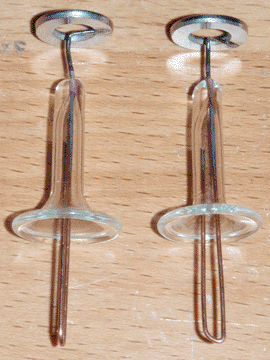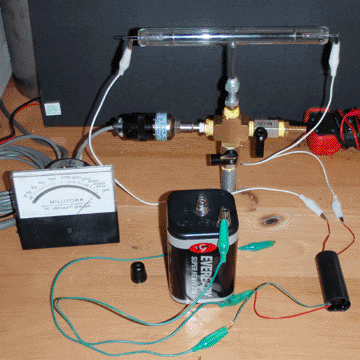
A vacuum gauge is one of the more expensive pieces of equipment required to make vacuum tubes. However, a crude gauge can be made using less than $5 in parts. The Geissler tube is simply a low-pressure air discharge tube. By observing the characteristics of the discharge, a rough estimate can be made of the pressure inside the tube.
As an experiment, I made the seals for this tube using 0.7mm MIG wire. This worked suprisingly well, and with a little practice I could get bubble-free seals. The seals are not pinched; instead I just spun the assembly on the lathe and heated the end of the glass until it gathered together around the wire. Once the seal was made, I spot welded a stainless steel washer onto the end of each feedthrough, to increase the size of the electrodes so that any glow discharge would be more clearly visible. I then fused the seals into the ends of a 7.75 inch length of 18mm tubing with an evacuation stem on the side. In the completed tube (pictured above) the washers are 5 inches apart.
The tube was then connected to the vacuum manifold, and a power supply was made from a 6-volt battery and a $2 high-voltage module from ebay. Below are pictures of the MIG wire seals mentioned earlier, and the complete setup used for testing the tube.


The tube was then evacuated to various pressures (measured by the thermocouple gauge on the left) by adjusting the valves on the manifold, and the following results were recorded:
1 torr


Near atmospheric pressure, the discharge began as a long spark, which slowly became more diffuse as the pressure decreased. At lower pressures, the glow began to separate into two colors, pink at the anode and purple at the cathode. By 1 torr the colors were clearly separated, with a space between them. As the pressure fell further, the colors became dimmer and blended together in the middle of the tube, and by 50 millitorr the glow was barely visible. Below 30 millitorr however, a new phenomenon occurred. The tube would flash blue-purple in the middle and the glass would fluoresce, visible around the edges of the tube in the bottom picture. Conveniently, I have found 30 millitorr to be the upper limit for the reasonable operation of a triode. In the absence of a proper vacuum gauge, this type of glow could be used as an indicator of good vacuum before sealing off a tube.
With the quality of pump I have, this was all fairly safe, but with a better vacuum pump care must be taken to avoid the production of x-rays. As a safety measure, a 1cm spark gap should be connected in parallel with any unregulated high voltage source powering the tube. That way, the voltage is limited to approximately 10KV. Below 10KV any x-rays produced would be very soft and would be unlikely to penetrate the glass.